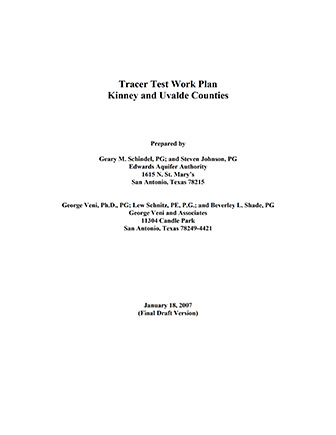Tracer Test Work Plan, Kinney and Uvalde Counties

| Author | GM Schindel, S Johnson, G Veni, L Schnitz and BL Shade |
| Year | 2007 |
| Description | Plan for dye tracer studies in Kinney and Uvalde Counties |
| Publisher | Edwards Aquifer Authority |
| Location | Edwards Aquifer, Balcones Fault Zone, San Antonio Segment, Kinney County, Uvalde County, Recharge Zone, Artesian Zone |
| Cover | View Download |
| File | View Download |
| Summary |
|
This Work Plan was prepared by Authority staff and defines the scope of work and the methodology that will be followed during tracer testing in Kinney and Uvalde counties. Groundwater movement in the Edwards Aquifer has been characterized primarily by well data, potentiometric surface mapping, and computer modeling. While each of these techniques provides useful information, tracer testing has long been demonstrated as one of the most effective tools in quantifying groundwater movement in karst aquifers. Tracer testing provides empirical data on groundwater behavior that can be used to delineate drainage basins, identify groundwater flowpaths, and measure groundwater velocities, dilution, dispersion, and storage. The results are far more meaningful and accurate when compared to similar results produced by computer groundwater modeling. The focus of this test is to investigate the sources of water for the principal springs in Kinney and Uvalde counties. Included in the study will be Pinto, Mud, and Las Moras springs in Kinney County and Leona Springs in Uvalde County. This test will be conducted under the auspices of the Edwards Aquifer Authority (Authority) and its contractor, George Veni and Associates. This work plan describes the procedures that the Authority typically implements for tracer tests in the Edwards Aquifer. It is based on the Authority’s knowledge of the groundwater conditions and the objective of obtaining scientifically valid results. Each activity within the work plan is affected by the results of the preceding work. For example, the results of the initial tracer injections will form the basis for planning subsequent injections. Consequently, some activities described in this work plan may be changed or omitted during the course of the tracer test. The Authority will prepare a report at the conclusion of the test to describe the actual methodology and findings. The report by Green and Others (2006) on groundwater resources in Uvalde and Kinney counties recommended a series of tracer tests to test the conclusions in the report. The objective of this tracer test study is to test the conclusions of the SWRI study by:
This work plan outlines a tracer test methodology for evaluation of the time-of-travel, direction, and destination of groundwater movement in a portion of the Kinney and Uvalde portions of Edwards Aquifer recharge and artesian zones. This section outlines the tasks and strategy to be implemented. Appendix A provides the project quality assurance and quality control (QA/QC) sampling protocols, as prepared by the Authority. Appendix B is a glossary of terms for this work plan. Appendix C is a conversion index from the International System of Units used in this report, to English units. Appendix D is a legend of cave map symbols. |
Search for Documents
Advance Search
Explore EAA's Scientific Reports
- All Reports
- Groundwater Movement
- Geomorphology and Caves
- Weather Modification
- Geology
- Water Use and Conservation
- Geochemistry
- Water Resources Planning and Management
- Floods and Drought
- Water Quality
- Climatology
- Surface Water / Groundwater Relationship
- Biology
- Springs, Groundwater Discharge
- Archaeology
- RZ Protection
- Aquifer Levels
- Remote Sensing
- Precipitation
- Overview Studies
- Modeling
- Hydrology and Hydrogeology
- History
- Groundwater Recharge, Recharge Zone
